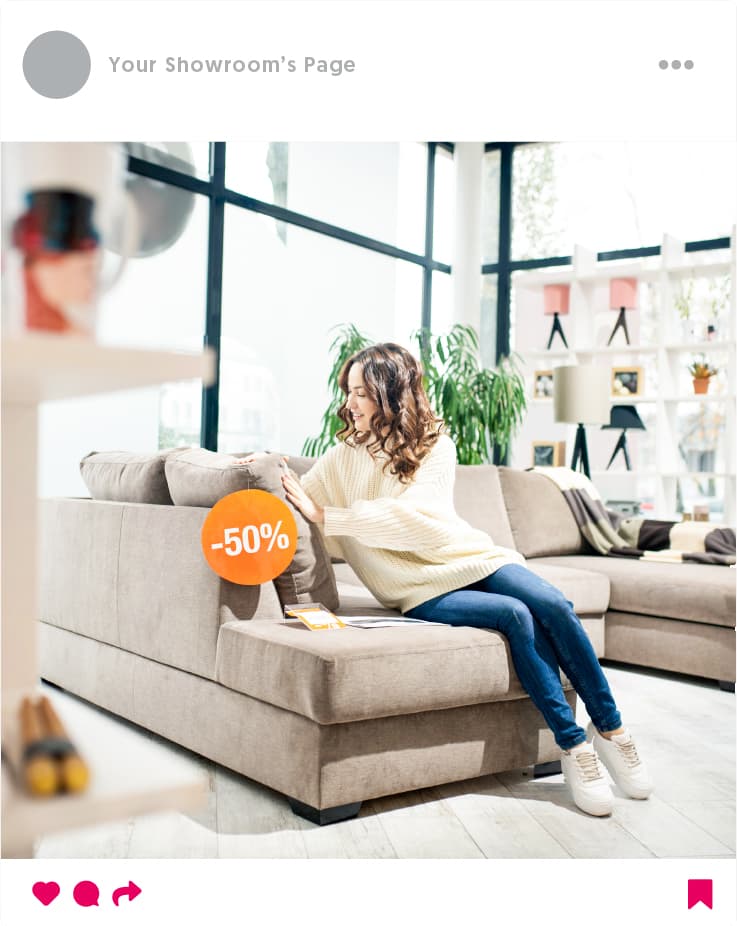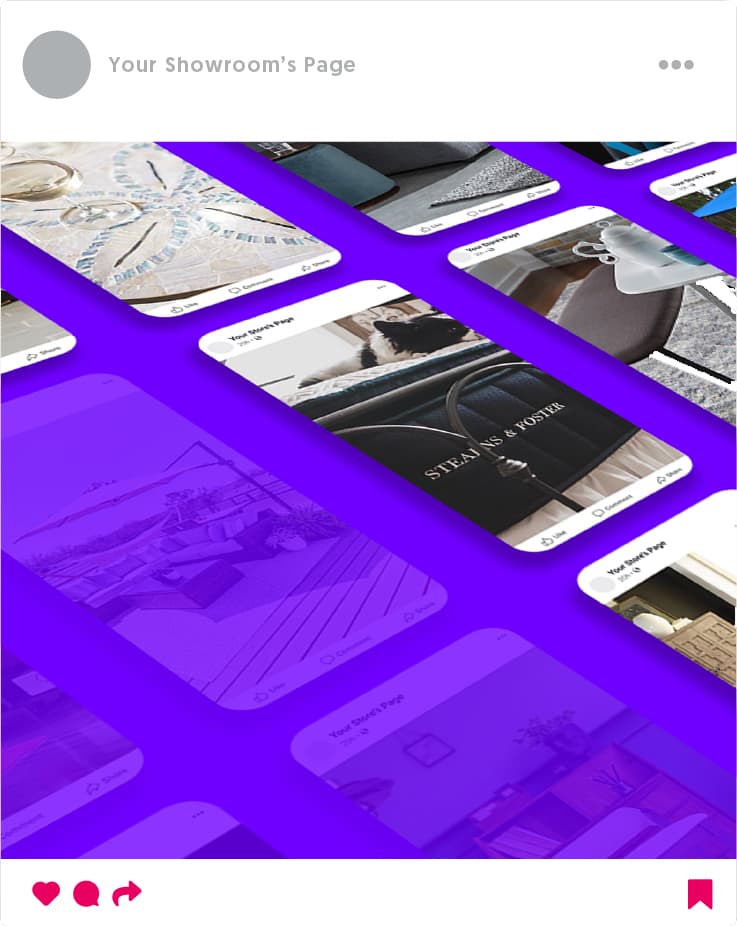Social Media Automation for Furniture Stores
Social media automation can power your furniture store’s ability to reach casual browsers to serious shoppers in your local area and turn them into customers.
Reaching Furniture Shoppers Where They Are
What Makes a Great Furniture Store Marketing Strategy
Your marketing strategy needs to combine the right elements, in the right places, aimed at the right audiences. No single marketing tactic will bring you all the furniture shoppers you want to see. A cross-channel digital strategy is the more effective route.
Find the right mix of traditional marketing tactics, like television, print and point-of-sale, with digital tactics like email, pay-per-click and social media.
Furniture shoppers want:
- Great visuals from many angles
- Product specifications
- Answers to their specific questions
- The ability to visualize a piece of furniture in their home
Social media can accomplish all of the above and more.
Social Media Marketing for Furniture
Social media offers a wide variety of methods for reaching different audiences to drive in-person and online traffic. It has to be part of your marketing mix. Social media can both attract traffic to your e-commerce website and attract in-person traffic to your store. In addition, it can build your brand’s reputation, increase customer loyalty by expressing your brand values, and allow your customers to become ambassadors for your store.
Follow these best practices for promoting your furniture store on social media:
- Position your products consistently with how the furniture makers position them
- Promote product features and timely promotions relevant to your local audience
- Maintain a steady, strategic flow of content to your channels
The Power of Automation
One way to save time and get the most out of social media is through automation. Automated Facebook posting for furniture retailers ensures a reliable supply of quality content in your Facebook feed.
Visuals and promotions from furniture brands you sell in your store can be directly posted to your social media feed, strategically timed to reach the largest possible portion of your target audience. You get the benefits of:
- Scheduling
- Automation
- Consistent management
- High-quality content
Shift your social media marketing into high gear with ThumbStopper’s automation platform.

Take Control of Your Social Media Marketing
7 Out of 10 Customers are Influenced by Social Media.
Learn to market your furniture store and build relationships on social media.
Brands We Work With
Featured Resources
CASE STUDY
How STIHL Canada Drove a Successful Co-Op Marketing Campaign Utilizing Marketing Technology
GUIDE
How to Get Retailers to Participate in Your Channel Marketing Program
Key Points:
- Companies should understand the Web Content Accessibility Guidelines (WCAG) to ensure their websites are accessible.
- Brands that concentrate on accessibility on social media demonstrate care for their customers and build a positive brand reputation.
- Brands should always consider inclusive design, such as plain, straightforward language, in their social media posts.
Accessibility may not be a term you usually associate with the internet and social media. You might picture wheelchair ramps, directional signs in braille, or sign language interpreters at live performances. The landmark Americans with Disabilities Act (ADA) of 1990 dictates the legal necessity of these and similar accommodations in public spaces. As we’ve come to rely on the internet for everything from entertainment to buying groceries, it’s become clear that the internet is now also a public space. It must be accessible to everyone. And like other applications of ADA, businesses that do not comply are liable for damages caused by inaccessibility.
The Web Content Accessibility Guidelines (WCAG) are an international set of standards to provide instruction on meeting accessibility needs. It’s important for companies to understand how this applies to their websites, especially if they engage in e-commerce. In terms of social media, the requirements are less concrete. But prioritizing accessibility on your company’s social media is essential to your reputation, even if the legal requirements are uncertain. We’ll look at why it’s important to your customers, how it affects the perception of your brand, and how to make these changes efficiently.
Social Media for All
The cornerstone of accessibility is inclusive design: products or experiences that are accessible for everyone regardless of disability. The most important place where this shows up is on company websites where most users expect to also find links to the brand’s social media profiles. Unfortunately, the overwhelming majority of websites are not accessible, despite the fact that the application of ADA to the internet is over 20 years old. Making websites accessible is a complex process without the use of specialized software like Accessibe or EqualWeb.
Unlike websites, making sure your social media is accessible is a straightforward, ongoing process. Every social platform has been quick to release optional accessibility features. These features are important to many users even if they don’t rely on them to use social media.
Making your social presence accessible tells users that your brand cares about people, not just profits. It’s the same idea as the push for the representation of different body sizes in fashion or more expansive skin tone ranges in beauty products. Brands that meet the needs of underrepresented groups endear themselves to others as well. And while optimizing your brand website for accessibility might be a larger project you aren’t ready to tackle yet, starting with your social media pages is a great way to show customers that you’re listening to their concerns.
Making Content Accessible
Shifting to accessible content means incorporating inclusive design into your creative process. The practice varies by type of media. For platforms that have graphics or videos with captions, it means not only adjusting each component but also being mindful of how they interact with each other.
For example, YouTube’s automatically generated closed captions and subtitles are often inaccurate. It's one of many examples where the caption generation software has issues picking up strong accents and mumbled words. This could be remedied with handcrafted video transcription services. If that’s not in the budget, the video creator could add their script or transcription to the video description.
None of the technology for accessibility is perfect yet. Teaching computers to digest complex information for human understanding is difficult, and the variations in disabilities further complicate it. The majority of adjustments creators need to make revolve around helping assistive technology better understand their content. Let’s look at how to make different kinds of content accessible.
Text
- Use plain language that’s easy to understand
- Avoid text in all caps
- Capitalize the first letter of each word in a hashtag, like #SocialMediaMarketing, a practice called camel-case
Videos
- Provide descriptive captions. Instead of just displaying the words people on-screen say, explain background noises and other sounds that are relevant to the scene.
- Add your own subtitles or enable auto-subtitles on the video platform of your choice
- Use captioning for live videos when possible
Graphics
- Use color contrast checkers to make sure low-vision people can see images
- Try not to completely rely on color to show contrast
- Add alternative text on each social platform
Distribute Accessible Content
Many users find their new favorite brand through social media. When disabled people (who make up 26% of the population according to the CDC) can’t access your brand’s social posts, you miss the opportunity to connect with a demographic that’s eager to engage in online communities. On a hyper-local level, that kind of connection goes even further.
That’s why ThumbStopper exists to help brands distribute their social content to their retailer network. Retailers can connect with their local audience - with your accessible, branded content - in a more personal way. And since content goes to their page automatically once they sign up, retailers can effortlessly promote your brand online while focusing on running their business.
Ready to see how ThumbStopper can help your brand improve its reach? Check out our brand reach calculator or book a demo.






